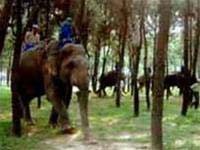The Forest Protection Department has submitted an urgent action plan to the Ministry of Agriculture and Rural Development to conserve wild elephants in Vietnam, which are facing a serious decline.
 |
|
The elephants of Buon Don in the enclosure at Trai Cung – Photo: VNN |
The Forest Protection Department, along with the Central Highlands provinces of Dak Lak, Nghe An, and Dong Nai, have collaborated to establish three special elephant conservation areas and set up three management boards for wild elephant conservation in these regions. The objective of this program to create special conservation areas is to enhance community awareness about elephant conservation, manage domestic elephants, and foster international cooperation to develop the genetic resources of wild elephants.
The Central Highlands elephant conservation area, covering 250,000 hectares, is protecting two wild elephant populations (about 128 individuals) in the forests of Dak Lak and the southwestern region of Gia Lai province. A 160,000-hectare conservation area has been established in the natural forests of Dong Nai province, which will safeguard more than 10 elephants, while a 200,000-hectare conservation area in the southwestern part of Nghe An province will protect around 20 elephants.
The main solutions proposed include protecting habitats and food sources, enhancing forest restoration and greening barren hills, eliminating illegal camps and shifting cultivation in the elephant activity areas, while also encouraging local communities to participate in forest protection and refrain from illegal elephant hunting.
In addition to the three special elephant conservation areas, Quang Nam province is also urgently establishing a 56,000-hectare elephant sanctuary in the western region of the province to protect the wild elephant herd that has been living there for many years.
The Central Truong Son Biodiversity Conservation Program for the period 2004-2020, being implemented by the Ministry of Agriculture and Rural Development, also aims to establish effective management areas for wild elephants in the provinces of the region by 2007.
Vietnam is one of 13 countries in Asia with wild elephant populations. However, the wild elephants of Vietnam are at risk of extinction, with a decline of up to 93% compared to 30 years ago—an alarming situation. In the years 1975-1980, Vietnam had up to 2,000 wild elephants, but by 2005, this number had dropped to fewer than 150 individuals, concentrated in provinces along the Vietnam-Laos and Vietnam-Cambodia borders.
According to a study by the International Union for Conservation of Nature (IUCN), wild elephants are becoming increasingly scarce, even in their primary habitats, such as the ancient forests of the Annamite Range, including the provinces of Dak Lak, Quang Nam, and Nghe An.
In the Dak Lak Highlands, a long-standing habitat for Vietnam’s wild elephants, by the end of 2005, there were only about 60 elephants left, halving from 1997 and down to 1/7 of the number from 30 years ago.


















































